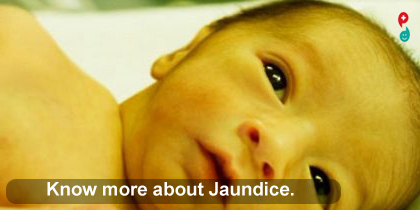
Jaundice
Jaundice is a yellowing of the skin and the whites of eyes that happens when the body does not process bilirubin properly. This may be due to a problem in the liver.
Causes
Bilirubin is a yellow-colored waste material that remains in the bloodstream after iron is removed from the blood.
The liver filters waste out from the blood. When bilirubin reaches the liver, other chemicals attach to it. A substance called conjugated bilirubin results.
The liver produces bile, a digestive juice. Conjugated bilirubin enters the bile, then it leaves the body. It is this type of bilirubin that gives feces its brown color.
If there is too much bilirubin, it can leak into the surrounding tissues. This is known as hyperbilirubinemia, and it causes the yellow color in the skin and eyes.
Risk factors
Acute inflammation of the liver: This may impair the ability of the liver to conjugate and secrete bilirubin, resulting in a buildup.
Inflammation of the bile duct: This can prevent the secretion of bile and removal of bilirubin, causing jaundice.
Obstruction of the bile duct: This prevents the liver from disposing of bilirubin.
Hemolytic anemia: The production of bilirubin increases when large quantities of red blood cells are broken down.
Gilbert's syndrome: This is an inherited condition that impairs the ability of enzymes to process the excretion of bile.
Cholestasis: This interrupts the flow of bile from the liver. The bile containing conjugated bilirubin remains in the liver instead of being excreted.
Rarer conditions that may cause jaundice include:
Crigler-Najjar syndrome: This is an inherited condition that impairs the specific enzyme responsible for processing bilirubin.
Dubin-Johnson syndrome: This is an inherited form of chronic jaundice that prevents conjugated bilirubin from being secreted from of the cells of the liver.
Pseudojaundice: This is a harmless form of jaundice. The yellowing of the skin results from an excess of beta-carotene, not from an excess of bilirubin. Pseudojaundice usually arises from eating large quantities of carrot, pumpkin, or melon.
Types
There are three main types of jaundice:
Hepatocellular jaundice occurs as a result of liver disease or injury.
Hemolytic jaundice occurs as a result of hemolysis, or an accelerated breakdown of red blood cells, leading to an increase in production of bilirubin.
Obstructive jaundice occurs as a result of an obstruction in the bile duct. This prevents bilirubin from leaving the liver
Symptoms
A yellow tinge to the skin and the whites of the eyes, normally starting at the head and spreading down the body
pale stools
dark urine
itchiness
fatigue
abdominal pain
weight loss
vomiting
fever
pale stools
dark urine
Prevention
Jaundice is related to liver function. It is essential that people maintain the health of this vital organ by eating a balanced diet, exercising regularly, and not consuming more than the recommended amounts of alcohol.
Treatment
The following treatments are used:
Anemia-induced jaundice may be treated by boosting the amount of iron in the blood by either taking iron supplements or eating more iron-rich foods. Iron supplements are available for purchase online.
Hepatitis-induced jaundice requires antiviral or steroid medications.
Doctors can treat obstruction-induced jaundice by surgically removing the obstruction.
If the jaundice has been caused by use of a medication, treatment for involves changing to an alternative medication







